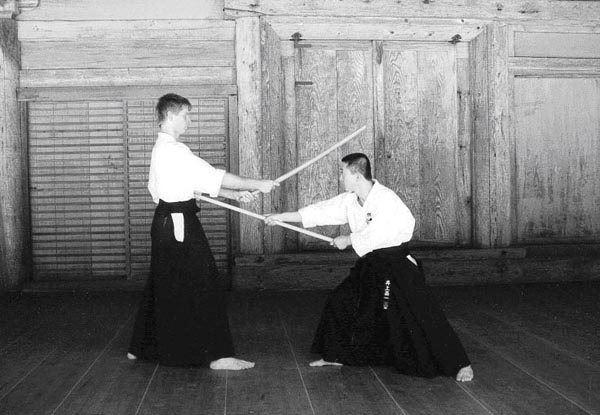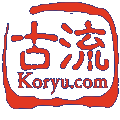Hontai Yoshin-ryu Jujutsu
Part 1
by Guy Buyens

The author with Inoue Kyoichi Sensei (present soke) demonstrating hanbo kata (sanbon-me) in Himeji in 1990.
Hontai Yoshin-ryu is one of the major surviving styles of jujutsu. As a traditional school, it is a member of the Nihon Kobudo Kyokai (Japanese Classical Martial Arts Association).
So far, little has been written in English on Hontai Yoshin-ryu, except for some articles by Stephen Fabian. I met Stephen in 1989 when I first arrived in Japan, where he helped me find my way around the dojo. At that time, I knew little about traditional budo, but I was very determined to study Hontai Yoshin-ryu, a school I first learned to appreciate in 1983 in Italy where, as a member of a karate group, I had the chance to participate in a martial arts event with members of the ryu. Since my first stay in Japan, I have tried to complement the things I learned in the dojo with different sources of information. This was mostly done by listening to the teachers of the school in the traditional after-training drinking and discussion sessions, but also by reading what is already available on traditional budo. Here I attempt to bring together some of this information. I will first introduce the school (Part 1), then cover jujutsu in some more detail (Part 2), and finally reflect on the long and never-ending journey (Part 3).
Hontai Yoshin-ryu originated in Oshu (present day Miyagi prefecture) in the Shiroishi district. The philosophy behind the school is nicely captured in its name, referring to the flexibility of a willow that can bend in the wind without breaking.
HON: Present; main; true; real
TAI: Body; substance; object; reality
YO: Willow
SHIN: Mind; heart; spirit
RYU: Style, method
The metaphor of the willow was incorporated into the school's name by its founder (shodai: first generation, founder), Takagi Oriemon Shigetoshi, born in 1635. The story goes that, after Takagi heard that his father had met his death in a night ambush, he killed his father's murderer. From that point on he took his father's teachings to heart: "a willow, yoboku, is strong, while a tall tree, takagi, will snap." From that time on he referred to himself as Yoshin-ryu Takagi Oriemon Shigetoshi. The name was completed by the second soke, Takagi Umanosuke Shigesada, who further developed the art, mastering mental disciplines and concepts to form a system that defeated the opponent with a "Willow Heart" (yo no shin). He called the system Hontai Yoshin [Takagi] Ryu Jujutsu.
Although the school originated in Oshu, it moved to the Owari district (Nagoya), the Tosa district (Koichi) and then to the Ako and Himeji districts (Hyogo). Later the headquarters dojo moved to the Kobe area and eventually to Nishinomiya. Counting from the founder (for convenience counted as the first), there have been nineteen generations of soke to date. The last ceremony of soke succession was celebrated on January 16, 2005. At that time the 18th soke, Inoue Tsuyoshi Munetoshi, conferred on his son the status of soke. Inoue Kyoichi Munenori, the 19th generation soke, lives and teaches in Nishinomiya, Japan.
Hontai Yoshin-ryu is a jujutsu school, which in addition to weaponless techniques, is also known for its use of the short sword or kodachi and its bojutsu.
The kodachi has always been an important part of the school. In fact, Kyochi-ryu sojutsu as well as Muto-ryu kodachi were among the schools that were studied by the founder of Hontai Yoshin-ryu. As for weaponless techniques and bojutsu, the most significant influence during the early existence of the school came from Takenouchi-ryu and Kukishin-ryu.
Takenouchi-ryu is an important jujutsu style that influenced the second soke of Hontai Yoshin-ryu, Takagi Umanosuke, who had received the teachings of Takagi Oriemon in 1671 at the age of 16. It is said that at one time Umanosuke and the third generation headmaster of Takenouchi-ryu, Takeuchi Kagasuke Hisakichi, fought a duel before Lord Mori Sadahisa, head of the Mori family. Two matches were held and although Takeuchi Hisakichi was only 4 foot 8 inches, compared to Takagi Umanosuke, who was a giant of 6 foot 8 inches, Hisakichi won easily. During the match, Umanosuke was thrown with Takenouchi-ryu's ganseki otoshi, locked on the ground and tied up with a cord. However, Umanosuke was so powerful that he was able to snap the normally strong arresting cord. In the second match, he was thrown with the same technique and was finally defeated by being stabbed with a sword. Later, Umanosuke saw his own arrogance and went to Takeuchi Hisakichi to apologize; he finally became a student, eventually receiving kaiden. [See Wayne Muromoto's retelling of this story, "Takeuchi Hisayoshi, the Little Warrior".]
Kukishin-ryu is the origin of Hontai Yoshin-ryu bojutsu. Indeed, one day, the third soke, Gennoshin (who, like his father Umanosuke, was a powerful man), met Okuni Kihei Shigenobu of Kukishin-ryu. Gennoshin tested his techniques against Okuni, with Gennoshin winning the unarmed side, and Okuni winning the staff side. The two decided to exchange techniques, taking on the strong points of both systems to complete the arts. After his friend Gennoshin died, Okuni Kihei became the fourth generation soke of Hontai Yoshin-ryu. From that time, the techniques of Hontai Yoshin Takagi-ryu, were taught together with the staff, spear and halberd techniques from Kukishin-ryu.
It is also interesting to note that Okuni Kihei Shigenobu also studied Tendo-ryu naginatajutsu, and this naginata school therefore influenced the development of Kukishin-ryu.
Hontai Yoshin-ryu has kata involving the short sword or kodachi; the long staff or chobo; the short staff or hanbo, and weaponless techniques, both against an unarmed opponent and against knife or tanto and long sword or tachi; and finally rope binding or toritsuke. The short stick or hanbo is the preferred weapon of the current soke, Inoue Kyoichi Munenori. The footwork of hanbo comes from kodachi, the handwork from chobo and the tactics are jujutsu. Therefore, truly mastering hanbo is only possible after having studied the main components of the school.
Since Hontai Yoshin-ryu is a jujutsu school, and therefore a bujutsu school, it is classified as a budo, but it is also considered to be kobudo and a koryu. But what does this mean?
The word budo in Japanese is usually translated as "martial arts," although the more correct translation is "martial ways." The translation of "martial arts" would be bujutsu. It is interesting to note that the characters for "bu" and "jutsu" were also used in China. Indeed, the term "wushu" consists of the same two Chinese characters: wu, meaning war, martial or military, and shu, which translates as art, skill, or method. Together they form the word "wushu" or "martial art." In Japan, the term budo, applies to all arts of a martial nature, whether or not they were developed by samurai, the classical hereditary warrior caste, or by commoners. However, the term "budo," can also be used in a more limited and structured fashion to mean only what Japanese call gendai budo, or modern budo. In that case, martial arts (bujutsu) systems that were developed prior to 1868 are called kobudo (old budo), or koryu (old tradition; old school). In a martial context and as a suffix, -jutsu is most frequently used for the martial arts or skills originating in the classical period of Japan's history (prior to 1868).
Jujutsu will be explained in more detail later but other examples of bujutsu include: bajutsu or riding a horse while fighting; hojojutsu or binding up a captured opponent; senjojutsu or the deployment of troops; noroshijutsu or the use of bonfires as signals; chikujojutsu or fortifying a position; bojutsu or the use of a staff; kenjutsu or the art of using the sword; iaijutsu or the art of drawing the sword, also known as batto; sojutsu or the art of the spear; naginatajutsu or the art of the glaive; jojutsu or the use of a stick, slightly longer than hanbo; kyujutsu or archery; kusarigamajutsu or the use of a sickle with weighted chain; tessenjutsu or the use of an iron truncheon-like fan; shurikenjutsu or the art of throwing small bladed weapons; suijutsu or swimming.
Although jutsu and do are often seen as technique versus philosophy, the two were obviously closely related. The bushi (warriors) who studied the techniques followed their encompassing (but unwritten) code of honor and social behavior, the so-called bushido (lit. way of the warrior). Jutsu, translated as "the art," is written with the radical element for "road," along with a phonetic character to mean "twisting and adhering." Most traditional schools that still teach these –jutsu, are doing this by following the path or michi (note that the same kanji can also be pronounced "do") towards self-perfection and are truly budo in philosophy. They are concerned with both physical and spiritual training, through the study of the art.
In the period where theTokugawa ruled the country, also know as the Edo period or Edo Jidai (1603-1867), traditional jujutsu was an important part of the education and training of the samurai. During that period, the most influential schools flourished and those of minor importance died and were forgotten because of their inefficient and unrealistic techniques. Eventually, the bujutsu schools became classified according to the main focus point of their teaching. For example, Ono-ha Itto-ryu was classified as a kenjutsu school, and Hontai Yoshin-ryu as a jujutsu school. In spite of the classification, many schools included both armed and unarmed combat. By the end of the Tokugawa period, there were records of 52 schools of archery, 718 schools of sword, 148 schools of spear, and 179 schools of jujutsu, including Hontai Yoshin-ryu. Today, the Hontai Yoshin-ryu tradition has a family of students both in Japan and around the world. The overseas dojo, officially acknowledged by the So-Hombu Dojo in Japan, are in Australia, Belgium, Canada, Finland, Italy, the UK, and the USA. The history of the school itself, as well as the list of overseas dojo, can be found on the official website: http://www.hontaiyoshinryu.com/.
In 1980, Hontai Yoshin-ryu was chosen as the subject for one in a series of documentaries on 58 existing schools of traditional martial arts produced by the Nippon Budokan. The videos of that series, entitled "Kobudo of Japan" are now also available on DVD. Although these presentations are in Japanese the visual material is excellent and they show some of the great teachers of the current generation. For those who want to see a description of the basic kata, there is a book written by Stelvio Sciutto (in Italian, but with many photos). I first saw Stelvio in Italy, in 1983, during the demonstration tour of martial arts in which members of Hontai Yoshin-ryu participated, but I really started to know him some ten years later. Stelvio is probably the only non-Japanese who has known three generations of soke, including the late Minaki Saburo Masanori. Although Stelvio is now a very good friend, I consider him as our sempai, and I am very grateful for all the efforts he has made to help introduce Hontai Yoshin-ryu outside of Japan.
In Part 2, I will cover in more detail jujutsu, which is in fact the essence of Hontai Yoshin-ryu.

Contact Koryu.com
Last modified on December 27, 2017
URL: https://koryu.com /library/gbuyens1.html
Copyright ©2022 Koryu Books. All rights reserved.
